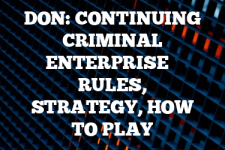Deception: Murder in Hong Kong – Rules, Strategy & Playing Tips
Introduction
Deception: Murder in Hong Kong is a game where players take on roles in a crime scene. One player is the murderer, trying to cover their tracks, while the others are investigators trying to solve the crime. It’s a social deduction game, which means you have to figure out who’s lying and who’s telling the truth.

The game was created by Tobey Ho and it’s been around since 2014. It’s really popular for our group game nights because it mixes together mystery, strategy, and trying to read people.
Quick Tip for Deception: Murder in Hong Kong
Always pay attention to how people act when they’re choosing their clue and means cards. Sometimes, you can catch a tiny hint that can lead you to the murderer!
Rules for playing Deception: Murder in Hong Kong
The rules are pretty straightforward. Each player gets a role: either an investigator, the murderer, or the forensic scientist. The forensic scientist knows the solution but can’t talk. They give clues to the investigators through special tiles. The murderer picks a clue and a means of murder from their cards, and they try to mislead the others. The game goes through rounds where the forensic scientist gives clues, and players discuss who they think the murderer is. If the investigators figure out the correct clue and means card, they win. If they can’t within a set number of rounds, the murderer gets away with it.
Equipment and Setup for Deception: Murder in Hong Kong
You need the game box to play. It comes with role cards, clue cards, means cards, and tiles for the forensic scientist. To set up, give each player their role in secret. The murderer picks their murder weapon and evidence from their cards without showing anyone. The forensic scientist gets their tiles ready to give clues. You can make your own versions of the cards and tiles if you don’t have the game, but it’s easier to just buy it.
How to Play Deception: Murder in Hong Kong and Game Mechanics
- Setup: Give out roles, murderer picks their cards, forensic scientist gets ready.
- Gameplay: The forensic scientist gives clues using tiles. Players discuss and try to solve the crime.
- End of the Game: If the investigators guess right, they win. If not, the murderer wins.
I’ll explain how each of these gameplay stages work in a bit more detail:
Setup
- Each player receives 4 red clue cards and 4 blue means cards, face up towards opponents. The number of cards may vary based on the chosen difficulty: 3 cards for easy or 5 for hard.
- Distribute 1 badge token to each player and randomly assign role cards based on the player count:
- For 4-6 players: 1 Murderer, 1 Forensic Scientist, and the remaining players as Investigators.
- For 7-12 players: Similar to the former setup with the optional inclusion of an Accomplice and, if used, an optional Witness (who observes the game but isn’t part of the core team).
- If an Accomplice is used, it’s announced that their job is to divert attention away from the murderer.
- The Forensic Scientist, who acts as the game master, discards clue and means cards and receives 6 bullet markers.
Game Start
- The Forensic Scientist starts the game:
- Says: “Everyone, close your eyes.”
- Then prompts: “Murderer (and Accomplice), open your eyes.”
- The Murderer selects their Key Evidence and Means of Murder cards while the Accomplice observes.
- The Forensic Scientist guides: “Murderer (and Accomplice), close your eyes.”
- If the Witness is in play: “Witness, open your eyes” (Forensic Scientist points to Murderer & Accomplice).
- Then directs: “Witness, close your eyes.”
- Finally announces: “Everyone, open your eyes.”
This sequence sets up the roles and initial information for each player in the game, establishing the parameters for the investigation and mystery-solving aspect of the game.
Here’s how the game progresses and how players can attempt to solve the crime:
Solving the Crime
- Once per game, excluding the Forensic Scientist, players may make a single attempt to Solve the Crime. They announce “Let me Solve the Crime!” and point to one clue and means card in front of another player.
- If both cards are correct, it leads to victory for the Forensic Scientist, Investigators, and Witness, concluding the game.
- If either card is incorrect, the Forensic Scientist responds with a simple “No,” and the player turns in their badge token. They can no longer attempt to solve the crime but continue participating in the game.
Round 1 – Evidence Collection
- The Forensic Scientist reveals the Cause of Death and selects one green Location of Crime, randomly drawing and displaying 4 orange Scene cards. They place the first bullet marker on one item on a tile.
- Players, excluding the Forensic Scientist, engage in open discussion about the investigation. The Forensic Scientist places the remaining bullet markers based on the ongoing discussion, offering clues without verbal communication. This phase ends when the 6th marker is placed, and discussion ceases.
Round 1 – Presentation
- Starting from the player to the left of the Forensic Scientist, Investigators present their opinions about the Key Evidence and Means of Murder within about 30 seconds each.
Round 2 & 3 – Evidence Collection and Presentation
- These rounds follow the same format as Round 1, with the Forensic Scientist introducing new Scene cards, adjusting bullet markers accordingly, allowing discussions, and presentations from Investigators.
The game revolves around deduction, discussion, and strategic placement of clues to help unravel the mystery. Players get limited chances to deduce the correct clues and solve the crime while using discussions and observations to gather information.
In the game, if both the Key Evidence and Means of Murder are correctly guessed and the Witness is part of the gameplay:
The Murderer and Accomplice have the opportunity to jointly select and “kill” one player before the trial phase. If their joint selection correctly identifies the Witness, the Murderer and Accomplice evade conviction, securing their victory in the game. This adds an additional layer of strategy and risk, allowing them to potentially evade capture by targeting the Witness correctly.
How to Win at Deception: Murder in Hong Kong
Winning depends on your role. If you’re the murderer, you want to mislead everyone. Choose common items as your murder weapon and evidence so it’s harder to guess.
A hidden strategy to win as the Murderer is (this works if the Key Evidence and Means of Murder are guessed right and the Witness is playing): Before the trial, the Murderer and Accomplice can choose to “kill” one player. If they correctly guess this player they “kill” as the Witness, they win without being caught. It’s a risky strategy that lets them avoid capture if they guess the Witness correctly.
If you’re an investigator, pay close attention to the clues and what other players are saying. Sometimes, the murderer will slip up. The forensic scientist should use their tiles wisely to point the investigators in the right direction without being too obvious.
Best Strategies for playing Deception: Murder in Hong Kong
In the social deduction game Deception: Murder in Hong Kong, players take on various roles, with the majority being Investigators trying to solve a murder, while one player is the Murderer attempting to evade detection. To excel in this game, it is crucial to employ effective strategies tailored to your role. If you are an Investigator, keen observation and communication are key; you must listen carefully to other players’ suggestions and watch for any inconsistencies in their statements.
Building trust with fellow Investigators can help you collaborate more effectively to pinpoint the Murderer. Conversely, if you are the Murderer, misdirection and subtlety are your best tools. Planting doubt and spreading confusion without drawing suspicion to yourself is essential. Offering plausible yet misleading clues can help divert attention from the evidence pointing to you.
Additionally, both Investigators and the Murderer should pay close attention to the Forensic Scientist, who provides vital clues to the murder scenario. Being able to interpret these hints accurately, or manipulate their interpretation if you’re the Murderer, can significantly influence the game’s outcome. Remember, in Deception: Murder in Hong Kong, it’s not just about what you say, but also about what you don’t say, and how you react to others’ accusations and observations.
Good strategies include bluffing if you’re the murderer, and being observant if you’re an investigator. Try to build a story around the clues if you’re the forensic scientist. And remember, communication is key. Talk to other players and see if you can figure out who’s not being honest.
Scenarios
If you find yourself stuck with a bad set of clue cards as the murderer, try to throw suspicion on someone else’s similar cards. If you’re an investigator and you’re not sure who the murderer is, ask questions and see how people react. Sometimes, the way they answer can give them away.
Frequently Asked Questions about playing Deception: Murder in Hong Kong game
Q: How many people can play? A: The game is best with 4-12 players.
Q: How long does a game last? A: Usually around 20 minutes to an hour.
Q: Can you play with just two people? A: It’s not recommended because it’s a social deduction game.
Q: Is there a way to make the game harder? A: Yes, you can add more roles like the accomplice or witness for more complexity.
Q: What if the forensic scientist gives bad clues? A: They should try their best, but sometimes it’s just a tough game.
Additional Tips for Deception: Murder in Hong Kong
Remember to keep a poker face, especially if you’re the murderer. And don’t forget, it’s just a game, so have fun with it!
External Links

Eve Brownlee was a gamer before gaming communities on the internet were a thing. Eve grew up playing traditional, standard deck card games like Rummy and Bezique, taking an interest in the classics Backgammon and Chess. Parlor card games like Bridge continue to keep Eve active in the community. After a long career, primarily in horticulture for USDA in Maryland, Eve now travels and writes on The Pineapple (pineapples.info) and contributes to Quora/Pinterest topics. Contact Eve via email.



